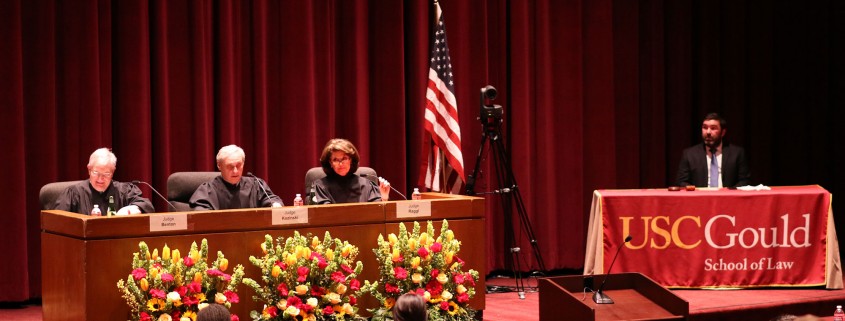Gould students compete in Moot Court final round
Four second-year law students went to the final round of the 66th Annual Hale Moot Court Honors Competition Saturday in Norris Theatre.
Students presented before a panel of three United States Circuit Court Judges and an audience consisting of their peers and professors. Law students Aja-Fullo Sanneh, Mary Alice DiPietro, Mark Swensson and Brittany Kitchen argued and defended their points on issues pertaining to computer fraud and fair labor standards.
The program, which aims to provide students with an opportunity to further develop their written and oral advocacy skills, kicks off every spring for first-year law students. Through a process that involves four eliminative qualifying rounds, participants are selected to advance in the competition based upon their oral and written skills in addition to their grade point averages.
The mission of the Moot Court competition is for participants to gain experience and confidence in the courtroom by presenting their own appellate briefs and engaging in oral arguments before judges and practicing attorneys. The program is one of Gould’s School of Law’s most prestigious honors programs, and to advance in the competition is a process that is both lengthy and difficult.
Each spring, all first-year students are invited to compete in qualifying rounds of the competition. They familiarize themselves with a fictional case that involves two issues; each student who chooses to participate in the program drafts an appellate brief on behalf of either the petitioner or respondent regarding one issue. In the fall, 40 of these now second-year students are selected to attend issue and oral advocacy clinics in preparation for the preliminary rounds, during which they present their arguments before panels consisting of state and federal judges, experienced attorneys and faculty members.
A student’s argument and appellate brief scores determine whether he or she is one of the 16 to advance to the quarterfinal round. The eliminating processes continue on to the semifinals, during which half of these 16 students are cut and then finally to the final round, in which only four of the original forty participants remain.
Though Sanneh, Dipietro, Swensson and Kitchen successfully weathered the many rounds of the Moot Court competition, ease was not something guaranteed in the final round. Yesterday’s case involved the Computer Fraud and Abuse Act and the Fair Labor Standards Act, two matters of relevance that provided for a mock courtroom brimming with unpredictability and tension.
The U.S. Circuit Court judges who oversaw the case, Alex Kozinski, Reena Raggi and William Duane Benton, grilled the four students with a string of questions that they weren’t always prepared for.
Bobby Allen, a fellow second-year law students who sat in the audience, commended the efforts of his peers.
“I think the students all did well and were well-prepared, especially given the circumstances of such a hot bench,” Allen said. “Kozinsky is well known for grilling attorneys in open court and is often very entertaining at the attorney’s expense.”
The judges often fired quips and witty remarks to one another, letting their jokes balance with tough questions that surprised the competitors from time to time.
According to Allen, Moot Court participants do not get much information about the case they are taking on. The program, instead, is more concerned about the research and broader legal knowledge that each student possesses in order to adequately argue for his or her side in this specific case.
At the conclusion of the program, the recipient of the Edward G. Lewis Champion Award is contingent upon the student’s oral delivery. This year’s final prize was awarded to Mary Alice DiPetro, who argued on behalf of the petitioner’s side on the interpretation of the Computer Fraud and Abuse Act. The runner-up was Brittany Kitchen, who argued the opposing side.
Once the winner was chosen, the judges stepped out of their stern characters, congratulated each participant and offered constructive argumentative and career advice.
“Take a second to think about what the judge has asked,” Kozinsky said. “There’s nothing wrong with silence in a courtroom. Just like a page with all writing from edge to edge without white space is difficult to read, a readable page is one with white spaces. Silence actually punctuates your argument and gives you a chance to engage with a thoughtful discussion with the judges.”

